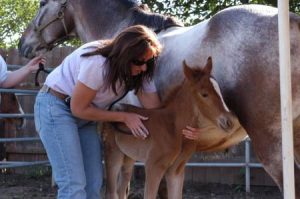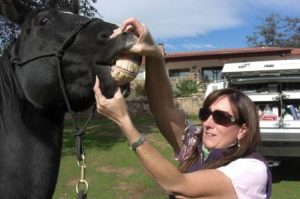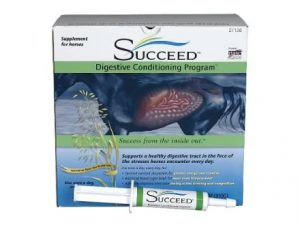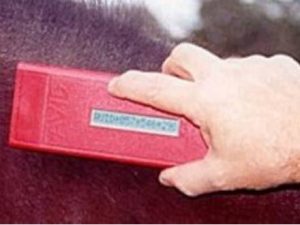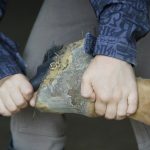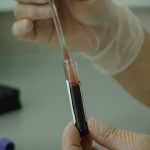Always observe your horse for normal behavior. Does your horse breathe hard, sweat excessively, bleed abnormally, or lie down at unusual times? Check for any weight loss related to disease, nutrition or conditioning. Has your horse experienced weight gain from overeating or decreased exercise? Observe your horse’s hair coat and evaluate it based on the time of year. Observe your horse’s environment. Are there changes in the manure, urine spots, bedding, feed bucket, or quantity of hay eaten? Check the water supply. Is the container full or empty?
In addition to your daily observations, you should be familiar with procedures for measuring your horse’s rectal temperature, pulse rate and respiratory rate.
The rectal thermometer should have a string and hair clip attached to it. Apply a Lubricant, such as petroleum jelly or K-Y Jelly, to the thermometer, and insert it into the rectum, attaching the clip to the tail hairs to prevent loss. The normal rectal temperature of a horse is 98 F to 101.5 F. It is typically higher in the evening than in the morning. The temperature also is influenced by the horse’s activity at the time the temperature is measured. Measure your horse’s rectal temperature at various times of the day and determine its normal range.
If your horse’s temperature is over 101.5 F, shake down the thermometer and take another reading. A common cause of an apparently elevated temperature is a "hot," unshaken thermometer.
To estimate your horse’s body temperature without use of a thermometer, use your finger to assess the temperature of the mucous membrane inside the lips, at the corner of the mouth. Compare your estimated reading with a thermometer reading twice on 10different horses. This will" educate" your finger to help you estimate the temperature by feel.
If your horse resists temperature measurement using a rectal thermometer, be persistent until the animal learns to tolerate it. This may eventually be important in monitoring a life-threatening medical condition or may be necessary as a part of competition.
A pulse represents a wave of blood propelled through an artery by a heart beat. Counting your horse’s pulse takes practice; try it twice on 10 different horses. You will need a watch with seconds displayed. You can count the pulse rate for 15 seconds and multiply that number by 4. If the horse has a rapid pulse rate, you can count the rate for 6 seconds and add a 0 (multiply by 10). The normal pulse rate ranges from 32 to 52 beats per minute.
To check your horse’s pulse rate, find an artery, partially compress it with a fingertip and wait for the pulsating sensation. The pulse rate of horses is much slower than that of people (by approximately 50%). If you compress the artery too much, you obstruct the blood flow and will not be able to feel a pulse.
The mandibular artery is located just to the inside of the lowest (largest) part of the jaw bone. The artery runs perpendicular to the bone and can easily be compressed against the jaw bone.
The palmar digital artery is located at the posterior (back) groove behind the suspensory ligament, just in front of the sesamoid bones in the middle of the fetlock. This pulse is more intense when there is increased blood flow to the foot (normally from exercise or abnormally from pain or inflammation). This artery is not commonly used to determine the pulse rate but it is very important in assessing foot problems, such as abscesses, laminitis, or other causes of foot inflammation.
These 2 arteries feel like firm, cooked noodles about 1/8 inch in diameter. Move your finger back and forth over the area and the artery will bounce back as your finger passes over it.
You can use a stethoscope to determine your horse’s heart rate. You can purchase an inexpensive one at a drug store. A stethoscope is the easiest, safest and most accurate way to count the heart rate. Stand on the left side of the horse at the shoulder and find the point of the elbow. To make sure the stethoscope is working, tap very gently on the diaphragm while the earpieces are fixed in your ears. Press the bell of the stethoscope into the chest wall and listen carefully. To determine the point of loudest heart sound intensity, move the bell around the chest wall while continuing to press firmly.
The main cause of an increased heart or respiratory rate is excitement. Therefore, it is best to make repeat counts after the horse has become less excited. Consider your own safety when evaluating a horse’s temperature, pulse and respiration, especially when the horse is abnormal. Be prepared to avoid kicking, being hit in the head with the horse’s knee when you are bending to check the digital pulse, and throwing of the head during assessment of the mandibular pulse.
If you have any questions or concerns on your horse’s vital signs please contact us at 619-659-1180 .


